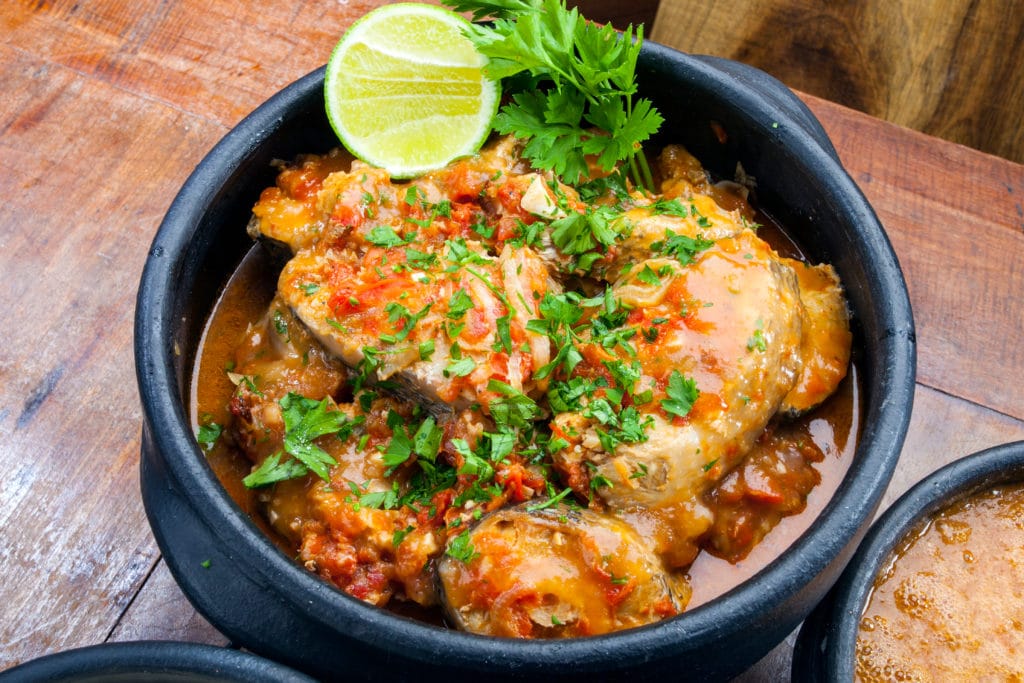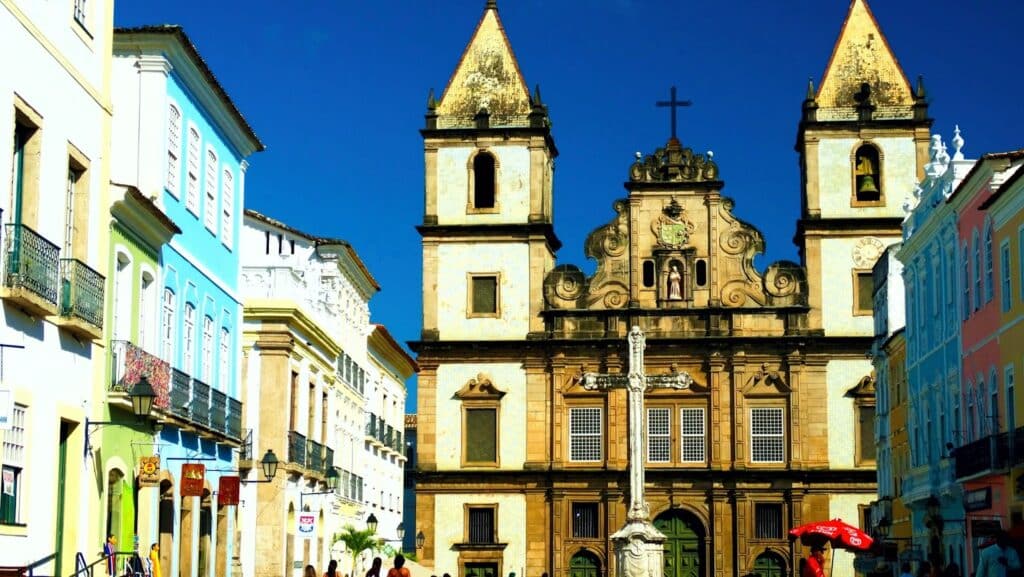Since Brazil’s population overwhelmingly identifies as Christian, it’s no surprise that most Brazilians take Christmas seriously, whether they’re religious or not. Some customs and traditions of Christmas in Brazil are similar to those found in North America and Western Europe, but others are unique to the country.
If you’re in Brazil for the holidays or hosting someone from Brazil for Christmas this year, our team at Remitly has you covered. Here’s what you’ll want to know about some of the local Brazil Christmas traditions and popular holiday activities Brazilians enjoy across the country.
What is Christmas Called in Brazil?
Brazilians call Christmas “Natal,” the Portuguese name for the holiday. Portuguese is the official and most widely spoken language in the country. To say “Merry Christmas,” use the phrase “Feliz Natal.”
Between Christmas Eve and New Year’s Day, Brazilians often say “Feliz Ano Novo,” which means “Happy New Year.”
The phrase “happy holidays,” or “boas festas” (bo-oz fay-stus), isn’t widely used in Brazil, but some Brazilians may say it to expats or people of non-Christian faiths.
Common Ways to Celebrate Christmas in Brazil
Christmas is a public holiday in Brazil, so schools and most businesses close for the day. The country’s location in the Southern Hemisphere means Christmas occurs in the middle of the summer. Most Brazilians get four weeks of paid vacation, and many choose to take their time off immediately after Christmas. In addition to family gatherings and festive meals, Brazilians often partake in lively celebrations that include fireworks and music. As one of the many countries that celebrate Christmas, Brazil’s unique traditions reflect its diverse culture, blending influences from indigenous, African, and European heritage. The holiday season is also marked by vibrant street parties and extravagant displays, making it a truly unforgettable time for both locals and visitors alike.
Christmas Gifts in Brazil
Giving Christmas gifts is a big deal in Brazilian culture. Consumer spending in Brazil rises during December. Even during the height of the pandemic in 2020, retail sales totaled R$37.5 billion during the Christmas season.
Many people buy gifts for their entire family, including aunts, uncles, and even second and third cousins. As a result, shopping malls are very busy during Christmas time.
To keep costs down and still exchange gifts, some families opt to play Secret Santa. The Brazilians often call it “Amigo Secreto” (secret friend) or “Amigo Oculto“ (hidden friend).
With a Secret Santa exchange, everyone who wishes to participate in the gift exchange puts their name into a hat or basket. Each person draws a name and then buys a special present for that person.
On Christmas Eve, everyone gathers with their wrapped gift. One by one, each participant stands and describes the person they picked without saying their name. Everyone tries to guess who the recipient is, and then the lucky person receives their present to open while everyone else watches.
Papai Noel and His Reindeer Sleigh
Brazilian children look forward to visits from Santa Claus each year, but he’s called Papai Noel there.
In anticipation of his arrival, little ones leave out socks for him to exchange for presents. Like North America’s Santa Claus, Papai Noel lives at the North Pole, wears a red-and-white, fur-trimmed suit, and drives a reindeer-pulled sleigh.
In Brazil, though, he often wears silk in red and white to beat the Brazilian summer heat.
Christmas Decorations in Brazil
Many Brazilians decorate their homes to get into the Christmas spirit.
Many cities and villages decorate light posts for the holidays to bring citizens together with Christmas cheer. Both public and private Christmas decorations include string lights and many of the same traditional symbols popular in the U.S. and Canada, including Santa Claus, jingle bells, candy canes, and holly.
Some people wonder if Brazilians decorate palm trees for Christmas, but they don’t. However, many families do put up a traditional Christmas tree. Most people opt for an artificial Christmas tree because real evergreen trees are hard to come by.
Decorations for Christmas trees include the usual fairy lights and ornaments. To add a wintry touch, many people finish their Christmas trees with artificial snow.
According to tradition, Christmas decorations remain in place only until Three Kings Day on January 6, a holiday that marks the official end of the Christmas season.
Christmas Traditions in Brazil
Brazilian Christmas traditions vary, but these are some of the most popular.
Midnight Mass
For the nearly two-thirds of Brazilians who are Catholic, attending Midnight Mass on Christmas Eve is a long family tradition. Brazilians call this mass “Missa do Galo,” or the Rooster mass. The name comes from the idea of the rooster’s crow ringing in the new day, just as Midnight Mass marks the official start of Christmas Day.
Presépio
Many families have a presépio or Nativity scene they display each year. Those with artistic talents may paint their own, but you can also purchase them in stores. Unpacking and arranging the figurines is an event in many families.
Champion’s Lunch
In the afternoon on Christmas Day, families gather for a laid-back meal of leftovers from the previous evening’s feast.
Beach Trips
In coastal areas of Brazil, the afternoon and evening of the 25th may be spent on the beach, soaking in the sun and swimming in the sea. Extended families from all over may meet at their favorite beach for a few days of enjoying the summer weather.
Paycheck Bonuses
Most employers pay employees a sizable bonus during the holiday season. In some cases, workers receive an entire month’s extra salary, or a “13th salary,” in honor of Christmas.
What’s for Christmas Dinner in Brazil?
Due to Brazil’s heritage as a former Portuguese colony, local cuisine borrows elements from Portuguese and Spanish fare. Many Italian and German immigrants settled in Brazil during the 19th century, bringing their culinary traditions. As a result, traditional Christmas food in Brazil often includes elements of European cuisine.
Christmas Dinner in Brazil

For most families, the main celebrations for the holidays take place late on Christmas Eve and go on for hours. Families who attend mass at midnight may have their meal immediately before or after the service.
Those who don’t, like Brazil native and Remitly employee Marlon D., usually start the celebration a little earlier. “My family always celebrates Christmas by barbecuing all types of meats: beef, lamb, and sometimes turkey,” he says. He also enjoys sharing stories of how his family’s festive gatherings differ from the lavish holiday meals seen in other cultures. For instance, he often compares their barbecued feasts to the elaborate Christmas traditions in France, where families might indulge in a rich array of dishes like foie gras and bûche de Noël. Despite these differences, Marlon believes that the spirit of togetherness is what truly makes the holiday special.
Other foods you might find at a Brazilian Christmas feast include roast turkey or Chester (a round ball of turkey breast), ham or pork leg, rice, cod, and lasagna.
Many families also serve traditional Brazilian dishes, such as farofa, dried cassava flour mixed with bacon, salt, butter, and seasonings, and salads featuring mayonnaise and raisins.
Marlon says on the holiday dinner table, “There’s always rice and salads—especially mayo salads.”
Salada de maionese is a salad with boiled potatoes, green beans, carrots, and olives served in a mayonnaise-based dressing. Salpicão, another popular mayonnaise salad, is composed of roast chicken, peas, corn, apples, onions, and raisins.
“We add raisins to as many dishes as possible,” says Marlon. “That’s a thing in Brazil for Christmas especially, and there are jokes about it everywhere since some people hate raisins.”
Decorating the table for the big meal is part of the fun each year. Brazilians will drape Christmas-patterned tablecloths over their tables to make everyone feel merry while enjoying potato salads, sweets, and other great food.
Christmas Desserts in Brazil
The big family meal usually ends with delicious desserts, including stollen, a German bread filled with dried fruit, nuts, and spices, or panettone, an Italian dessert bread made with candied fruits and a domed top.
Other popular Christmas desserts include cabanada, a Brazilian twist on French toast, and pavê, a layered dessert made of biscuits and cream similar to tiramisu.
What are Some Popular Christmas Activities in Brazil?
If you are in Brazil during the Christmas season, you can get into the holiday spirit in a number of ways. From vibrant street markets filled with festive decorations to enjoying traditional meals with family, the atmosphere is lively and colorful. Many Brazilians also pay homage to their Portuguese heritage by incorporating christmas traditions in portugal, such as the popular dish of bacalhau served on Christmas Eve. Music and dance fill the air, making it a joyful time to celebrate with loved ones.
Visit a Nativity Scene
Many churches set up large outdoor nativity scenes. On certain evenings, actors and live animals may replace the statues, and choirs may perform carols. Churches usually serve refreshments to the public during these live nativity scenes.

Attend a Christmas Play
Many communities host a Christmas play called “Os Pastores“ or “The Shepherds.” The play tells the story of the nativity, but with an unexpected twist — usually, there is a shepherdess who tries to steal the baby Jesus when she visits him.
Watch a Fireworks Display
On Christmas Eve, many cities and villages host fireworks displays. People often gather in the streets to watch. Sometimes, choral performances precede or follow the fireworks show.
Get in a Festive Mood with Music
Music is a big part of Christmas in Brazil, says Marlon, whose favorite Christmas song is “Então é Natal” by Simone. Original Brazilian Christmas songs are just as beloved here as the globally known standards, and they’re played throughout the season in public places.
Brazilians also have their own versions of many traditional carols and holiday tunes, including “Sino de Belém,” sung to the melody of “Jingle Bells” and “Noite Feliz,” which is “Silent Night” with Portuguese lyrics.
See the World’s Largest Floating Christmas Tree
If you’re in Rio de Janeiro for the holiday season, plan to visit the Rodrigo de Freitas Lagoon to see the centerpiece of Rio’s famous festival of lights. Towering at 278 feet, the display is the tallest floating Christmas tree in the world.
Due to the size of the huge Christmas tree, more than 3 million lights are necessary to illuminate it, powered by five generators located on barges.
The lights cycle through a series of colors: orange to symbolize sunrise, blue to symbolize the moon, green and gold to match traditional Christmas colors, and multicolored.
Typically, the city government lights the tree in early December. The floating tree moves throughout the bay nightly until January 6th.
While in Rio de Janeiro, you can also check out the permanent, open-air Saara market, which spans 11 city blocks. It transforms into a Christmas market during the holiday season, where local vendors sell decorations and gifts.
Frequently Asked Questions (FAQs)
What is Santa called in Brazil?
The influence of the USA is evident in modern Brazilian Christmas celebrations, particularly the idea of Santa. Brazilian children look forward to visits from Santa Claus each year, but he’s called Papai Noel, or Bom Velhinho, meaning “the good old man” in English. Secret Santa is a popular game, but instead of “Santa,” they use the term “amigo secreto” (secret friend) or “amigo oculto“ (hidden friend). Like North America’s Santa Claus, Papai Noel lives at the North Pole, wears a red-and-white, fur-trimmed suit, and drives a reindeer-pulled sleigh. In Brazil, though, he often wears silk in red and white to beat the Brazilian summer heat.
What colors does Brazil use for Christmas?
Traditional colors include red, which is widely used in decorations and clothing, green, often seen in Christmas trees and wreaths, gold and silver, commonly used in ornaments and festive décor, and white, typical in lights and decorations. If you’re in Rio de Janeiro for the holiday season, you can see the Rodrigo de Freitas Lagoon and the centerpiece of Rio’s famous festival of lights. The lights cycle through a series of colors: orange to symbolize sunrise, blue to symbolize the moon, green and gold to match traditional Christmas colors, and multicolored.
What are typical Christmas foods in Brazil?
Due to Brazil’s heritage as a former colony of Portugal, local cuisine borrows elements from Portuguese and Spanish fare. Many immigrants from Italy and Germany settled in Brazil during the 19th century, bringing their culinary traditions.
Foods you might find include roast turkey or Chester (a round ball of turkey breast), ham or pork leg, rice, cod, and lasagna. Another staple is rabanada, a Brazilian version of French toast, often served with cinnamon and sugar.
Many families also serve traditional dishes like farofa, dried cassava flour mixed with bacon, salt, butter, and seasonings, and salads featuring mayonnaise and raisins. Desserts include stollen, a German bread filled with dried fruit, nuts, and spices, and panettone, an Italian dessert bread made with candied fruits and a domed top.
What are some unique Christmas traditions in Brazil?
In Brazil, the Christmas celebration is known as “Natal.” Churches set up large outdoor nativity scenes and actors and live animals replace statues while choirs perform carols. Churches also serve refreshments to the public.
Many communities host a Christmas play called “Os Pastores“ or “The Shepherds.” The play tells the story of the nativity, but with an unexpected twist — usually, there is a shepherdess who tries to steal the baby Jesus when she visits him.
Most Catholics attend a midnight mass service called “Missa do Gallo” (Mass of the Rooster) and on Christmas Eve, many cities and villages, including São Paulo, host fireworks displays after mass. Streets are adorned with lights and decorations.
As a melting pot of cultures in South America, Brazil’s Christmas celebration is a true reflection of its diverse heritage.

